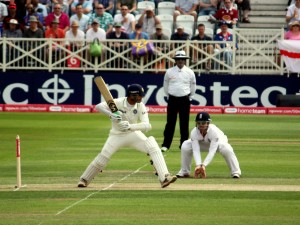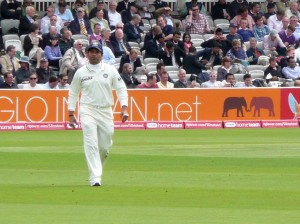The Battering Ram and the Wall
Friday, March 9th, 2012Fulsome tributes have been paid this week to two greats of the game. In one case it’s been a celebration; the other, farewell.
Viv Richards turned 60 on Wednesday. Today, Rahul Dravid announced his retirement from international cricket. Richards is a reminder of a once combative, proud nation, a conquistador with a cause; Dravid the consummate gentleman and understated technician, the velvet glove with the concrete core who gave his team backbone when it needed it while flashier performers stole the limelight.
Both men were major players in the forging of their countries’ national sporting identities and the casting off of the remnants of colonialism; both men were two of the greatest there have ever been.
Viv was a warrior: every match he played in a fierce skirmish between bat and ball which he regularly won. He may have called his bat his sword, but during his greatest achievements – 291 against England at the Oval in 1976, 182 not out at Bridgetown in 1981, fastest Test hundred against England in Antigua in 1986, to name but three – he wielded it like a hammer.
Dravid, though he may have laboured in Sachin’s shadow, was no mere shield-bearer. Like the man himself, his achievements, and the manner of their making, do not shout; it is only when you take the time to look at them that you realise their unarguable greatness. Second highest run-getter in the world in Tests; first Indian to score consecutive hundreds in four Test innings; possessor of five Test double hundreds; first player to score a century in all Test-playing countries… you will read many such lists today, and you will marvel at the numbers and at the longevity. There’s something gratifying about the fact his retirement comes while his performances in the England series last year are still so fresh in the memory, a series in which he shone while his team mates struggled. It’s always tempting to hope an old campaigner has one last fight in him; Dravid has walked away now while the decision is still his to make.
Aggression and eloquence; calmness and sheer force of personality; the battering ram and the Wall: Viv Richards and Rahul Dravid are two sides of a priceless coin that may no longer be in circulation, but that has given the sport such a store of riches to look back on.
Viv’s post-retirement career has not been smooth. Stanford ambassadorship; the travesty of the ground in Antigua named after him exposed as an unusable sand-pit during the England series of 2009. Such is the fragmented, troubled nature of West Indies cricket, the bickering between players and board and of the islands’ administrations with each other, that a man whose deeds could be used to inspire so many of the nation’s up-and-coming talent now chooses to steer well clear of any political involvement.
Dravid, similarly, is too valuable a statesman to be lost to the game, but whether he will feel similarly wary of the endless politicking of the BCCI and ICC remains to be seen.
All nations need their legends, reminders of what a country has achieved and of the heights it can reach again. Cricket in India and the West Indies is in a period of transition. India have yet to properly embark on their rebuilding; the West Indies have been in this phase for a long time but it has mostly been a case of one step forward, two steps back. If Viv Richards was the bullet fired at the heart of English and Australian superiority, the gun West Indies cricket is now wielding seems pointed squarely at its own feet. It says something that the only West Indian player who currently approaches Richards’ genius and swagger – Chris Gayle – is not even playing for his national team.
Whatever happens, the legacy of Dravid and Richards will remain untouchable. What they have given us, we will always have.
Of course time moves on. Sport, like so many other walks of life, is no country for old men. When Jeff Beck and Eric Clapton first heard a 20-year-old Jimi Hendrix play at a concert in London in 1966, they felt they should retire. Perhaps Dravid reached the same decision while watching Virat Kohli flay Lasith Malinga around the ground during that jaw-dropping 133 not out in that Commonwealth Bank Series group game in Hobart that got so many talking.
In common with many other England fans, Dravid, as sportsman and individual, has always appealed to me more than Tendulkar. Sachin’s greatness is such that he has been raised to the level of archetype, icon, god; as a person, he is essentially unknowable. There are obviously depths, but they are closely protected. That this is down to the hysterical adulation which greets his every achievement is understandable. Dravid has always seemed more human, more accessible. Erudite and well-read – with a wide range of interests including history, politics and nature conservation – he is a man who is blessed with an extraordinary sporting gift but who also recognises the importance of the world beyond the boundary and his place in it.
During his Bradman Oration in Canberra last December, Dravid quoted the Don’s words about leaving the game better than you found it. The game may or may not be better – there are compelling arguments for both – but it is different. Dravid said today that he would play in this year’s IPL (if you want a symbol of how much the sport has changed, look no further) and then he will decide on his future. It would be nice if he could stay involved with the sport in some way. Because cricket without the continued benefit of Dravid’s wisdom – and his clear-headed recognition of the challenges it now faces – would be so much the poorer.

